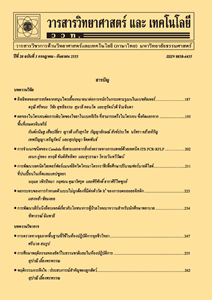ศึกษาการผลิตข้าวโพดหมักจากวัสดุเหลือใช้ทางการเกษตร
Main Article Content
Abstract
บทคัดย่อ
การศึกษานี้มีวัตถุประสงค์เพื่อประเมินคุณค่าทางโภชนะและการย่อยได้ในกระเพาะรูเมนโดยวิธีแบชคัลเจอร์ของต้นข้าวโพดฝักอ่อนหมัก โดยวางแผนการทดลองแบบสุ่มสมบูรณ์ (CRD) มี 5 ทรีตเมนท์ 4 ซ้ำ คือ ต้นข้าวโพดฝักอ่อนหมักที่ไม่ใช้สารเสริม (กลุ่มควบคุม) ที่เสริมฝุ่นข้าวโพด 10 % ที่เสริมกากน้ำตาล 1 % ที่เสริมร่วมกันระหว่างฝุ่นข้าวโพด 10 % และกากน้ำตาล 1 % และที่ผลิตโดยเกษตรกร (อ.หนองเสือ จ.ปทุมธานี) จากการศึกษาพบว่า ข้าวโพดหมักทั้ง 5 กลุ่มมีปริมาณอินทรียวัตถุและการย่อยได้โปรตีนไม่แตกต่างกันทางสถิติ (p>0.05) ซึ่งมีค่าอยู่ในช่วง 92.66-93.05 และ 62.67-65.37 % ตามลำดับ พบค่าความเป็นกรด-ด่าง การย่อยได้วัตถุแห้งและการย่อยได้อินทรียวัตถุของกลุ่มที่ผลิตโดยเกษตรกร (3.47, 47.54 % และ 46.16 % ตามลำดับ) ต่ำกว่ากลุ่มที่เหลือ (3.58-3.62, 49.45-50.57 % และ 47.85-48.83 % ตามลำดับ) อย่างมีนัยสำคัญทางสถิติ (p<0.05) พบการเสริมฝุ่นข้าวโพด 10 % และเสริมร่วมกันระหว่างฝุ่นข้าวโพด 10 % กับกากน้ำตาล 1 % ทำให้วัตถุแห้งและโปรตีนสูงขึ้นอย่างมีนัยสำคัญทางสถิติ (30.34, 30.35 และ 8.18, 8.28 % ตามลำดับ; p<0.05) เมื่อเทียบกับกลุ่มควบคุม (25.80 และ 7.39 % ตามลำดับ)ในขณะที่ผลผลิตของเกษตรกรมีโปรตีนสูงสุด (10.80 %; p<0.05) แต่มีปริมาณวัตถุแห้งต่ำสุด (23.04%; p<0.05) การสูญเสียวัตถุแห้งแต่ละกลุ่มมีความแตกต่างกันทางสถิติ (p<0.05) โดยพบ การเสริมฝุ่นข้าวโพด 10 % มีค่าน้อยที่สุดคือ 8.03 % รองลงมาคือ เสริมร่วมกันระหว่างฝุ่นข้าวโพด 10 % และกากน้ำตาล 1 % และ กลุ่มควบคุม ตามลำดับ (12.56 และ 14.52 % ตามลำดับ) ขณะที่การเสริมกากน้ำตาล 1 % มีการสูญเสียมากที่สุด (16.80 %) พบต้นข้าวโพดฝักอ่อนหมัก กลุ่มควบคุม กลุ่มที่เสริมด้วยฝุ่นข้าวโพด 10 % กลุ่มที่เสริมกากน้ำตาล 1 % กลุ่มที่เสริมร่วมกันระหว่างฝุ่นข้าวโพด 10 % กับกากน้ำตาล 1 % กลุ่มที่ผลิตโดยเกษตรกร มีปริมาณแอมโมเนียไนโตรเจน 7.29, 5.10, 6.44, 5.44 และ 2.80 % ของไนโตรเจนทั้งหมด ตามลำดับ และแตกต่างกันทางสถิติ (p<0.05) พบการเสริมฝุ่นข้าวโพด 10 % หรือกากน้ำตาล 1 % หรือเสริมร่วมกัน ทำให้ค่าพลังงานลดลง (4381.38,4356.10 และ 4343.80 แคลอรี/กรัม ตามลำดับ; p<0.05) เมื่อเทียบกับกลุ่มควบคุมและผลผลิตจากเกษตรกร (4477.31 และ 4447.43 แคลอรี/กรัม ตามลำดับ) การศึกษานี้สรุปได้ว่า การใช้สารเสริมฝุ่นข้าวโพด 10 % และเสริมร่วมกับกากน้ำตาล 1 % ทำให้ข้าวโพดหมักมีวัตถุแห้งและโปรตีนเพิ่มขึ้น ปริมาณแอมโมเนียไนโตรเจนและการสูญเสียวัตถุแห้งลดลง การผลิตต้นข้าวโพดฝักอ่อนหมักของเกษตรกรได้ผลผลิตที่มีปริมาณวัตถุแห้ง การย่อยได้ วัตถุแห้ง และอินทรีวัตถุน้อยกว่าที่ผลิตในห้องปฎิบัติการ
คำสำคัญ : ต้นข้าวโพดฝักอ่อนหมัก; สารเสริม; ฝุ่นข้าวโพด; กากน้ำตาล
Abstract
The purpose of this study was to evaluate nutrient and rumen digestibility in batch culture of baby corn stalk silage (BCSS). The experiment was performed using CRD with 5 treatments and 4 replicates. The treatments were BCSS with out additive (control), BCSS with 10 % corn dust, BCSS with 1% molasses, BCSS with 10 % corn dust and1% molasses, BSCC produced by farmer (A. Nongseou, Pathumthani). The results showed that organic matter and protein digestibility of all the BCSSs were not significantly different (p>0.05) ranging 92.66-93.05 and 62.67-65.37%, respectively where as pH, dry matter digestibility and organic matter digestibility of BCSS produced by the farmer (3.47, 47.54% and 46.16%, respectively) were lower (p<0.05) than those of the rest treatments (3.58-3.62, 49.45-50.57% and 47.85-48.83%, respectively). Dry matter and protein contents of BCSS with 10% corn dust (30.34 and 8.18%, respectively) and BCSS with 10% corn dust and 1% molasses (30.35 and 8.28%, respectively) increased (p<0.05) when compared to the control (25.80 and 7.39%, respectively). BCSS produced by the farmer contained significantly higher protein (10.80%; p<0.05) but lower dry matter content (23.04%; p<0.05) than other treatments. Dry matter losses were significantly different among the 5 treatments. It was least in BCSS with 10% corn dust (8.03%), following by BCSS with 10% corn dust and 1% molasses and the control, respectively (12.56 and 14.52%) as BCSS with 1% molasses had the most (16.80%). Ammonia N concentration of BCSS with 10% corn dust, BSCC with 1% molasses, BCSS with 10% corn dust and 1% molasses, BCSS produced by the farmer were significantly different (p<0.05; 7.29, 5.10, 6.44, 5.44 and 2.80% of total N, respectively). BCSS added with 10% corn dust or with 1% molasses or, with both 10 % corn dust and 1% molasses had lower gross energy (4381.38,4356.10 and 4343.80 cal/g, respectively; p<0.05) than the control and BCSS produced by the farmer (4477.31 and 4447.43 cal/g, respectively). In conclusion, addition of corn dust at 10% or both 10% corn dust and 1% molasses increased dry matter and protein but decrease ammonia N and dry matter loss of BCSS. Dry matter, dry matter digestibility and organic matter digestibility of BCSS produced by the farmer were less than those of BSCC produced in our laboratory.
Keywords: baby corn stalk silage; additive; corn dust; molasses

